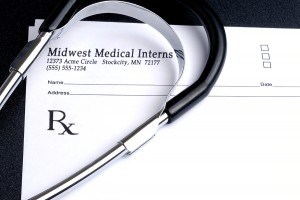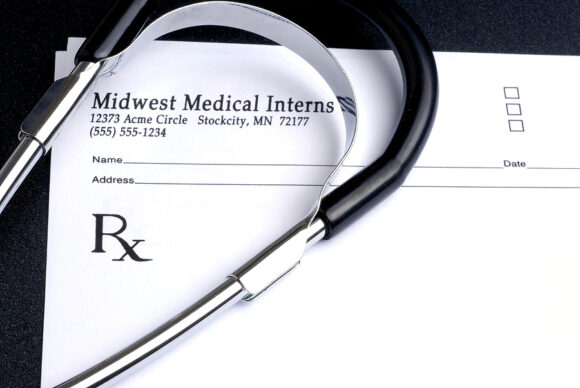The small pads that doctors use to scribble out prescriptions, a seemingly innocent part of the medical profession, have played a role in the surge of prescription drug abuse.
Take a diagnostic imaging center in California’s San Fernando Valley where investigators in March found thousands of unsigned pads that were stored there as part of a suspected Medicare fraud scam. Or the case of Dr. Lisa Barden in Riverside County where authorities found she had pads stolen from a dozen doctors to obtain Vicodin and Oxycotin.
There’s a growing sentiment among law enforcement and some legislators that in the computer age it no longer makes sense to rely on paper “scripts” that drug abusers and pill pushers can steal or fabricate to get what they want.
Those who are trying to combat prescription drug abuse believe creating a system that provides a direct link from a doctor to a pharmacy may be the best and more cost-effective solution.
That shift is slowly underway as the federal government offers bonus payments for doctors who voluntarily ditch the paper with 34 percent of office-based prescribers sending their scripts electronically through the Medicare program, according to SureScripts-RxHub, the nation’s largest network for paperless prescribing.
While only 17 percent of new or occasional abusers obtained painkillers through doctors’ prescriptions, according to data released last month by the Office of National Drug Control Policy, observers say there is no better time than now to get rid of the paper pads.
“It should all be done electronically as soon as possible,” said Sen. Mark DeSaulnier, D-Concord, who has authored bills dealing with prescription drug abuse. “There’s too much money involved and too much opportunity for the system to be abused.”
Scoring a prescription fraudulently has long been one of the scams in the criminal chain of prescription drug abuse and the paper forms have become a valuable commodity, commanding as much as $400 on the street, according to law enforcement officials.
California did away with its triplicate prescriptions seven years ago with tamper-resistant security forms that aimed at reducing fraud. But much like counterfeiting U.S. currency, criminals found a way to make their own batch of scripts or discovered other ways to get powerful painkillers like Oxycontin which can cost as much as $80 a pill.
“With computers these days, crooks have the tools,” said Sgt. Steve Operfman, who heads up a Los Angeles County sheriff’s health care fraud task force. “The problem is the paperwork always looks legitimate so it’s hard to spot for a deputy who is working patrol. Law enforcement usually isn’t up to speed on this.”
Opferman has seen prescription pads that are good knockoffs and he’s found others that have been signed by someone posing as a doctor who had recently died.
Thousands of blank prescriptions, along with a slew of painkillers and methadone tablets, were discovered at a diagnostic imaging center earlier this year. Opferman said prescriptions were for doctors who had offices at different locations. Under state law, prescription pads are supposed to be sent to the doctor’s registered address.
“That’s millions of dollars right there,” said Opferman, showing a picture of the discovery, which remains under investigation. “They shouldn’t have been there in the first place.
In Barden’s case, not only was she faking other doctors’ signatures, she also stole patients’ identities in order to score more than 30,000 painkiller pills. She eventually pleaded guilty to more than 270 felony counts and was sentenced to a year in jail with a suspended eight-year prison term.
“E-prescribing” has gained some traction across the nation as part of a push to computerize records, not necessarily to cut prescription fraud but rather to reduce medication mistakes for patients.
Electronic prescriptions are used for patients seeking medicine through the Medicare program and doctors willing to adopt the technology can receive incentive payments. Holdouts could find their Medicare payments cut.
In 2010, the Drug Enforcement Administration gave doctors the option to send prescriptions electronically for painkillers, but some say the new avenue is rarely used because the rules are too stringent.
“It’s not like it’s not doable, it’s just more complex than people are willing to deal with,” said Dr. Kenneth Adler, who practices in Tucson, Ariz. “I don’t think the DEA is wrong to have stricter requirements, but I think (e-prescribing) is more secure and would make my life a lot easier.”
Most states, including California, employ a database that allows doctors, law enforcement and pharmacies to determine if patients are filling more than their fair amount of prescriptions. Creating a similar database that eliminates the potential for fraud when a patient tries to fill an illegally obtained prescription would provide a more secure method in obtaining prescription drugs.
“It would give a lot more control and it holds the doctor a lot more accountable for what is going on,” said Javier Salaiz, the former head of a prescription drug abuse task force for the California attorney general’s office. “The reason why there is so much prescription fraud is because we’re making it easy for them.”
Even some of the printers who produce prescription pads and would be adversely affected realize sending prescriptions via computer is the future.
“Our business is document security and the prescription part of our business will disappear over the years to come because we believe things will be going electronic,” said Steve Singer of Illinois-based Micro Format Inc., a company licensed in California to provide prescriptions. “As more (doctors) go electronic I think it will solve some problems but may create some others.”
Was this article valuable?
Here are more articles you may enjoy.


 Two Chevron Workers Die of Injuries From Angola Platform Fire
Two Chevron Workers Die of Injuries From Angola Platform Fire  Citi Reverses Course on Firing of Japan Trader Five Years On
Citi Reverses Course on Firing of Japan Trader Five Years On  Chinese Hacked US Telecom a Year Before Known Wireless Breaches
Chinese Hacked US Telecom a Year Before Known Wireless Breaches  Fixing the Claims Experience Where It Matters Most: In the Mess
Fixing the Claims Experience Where It Matters Most: In the Mess 